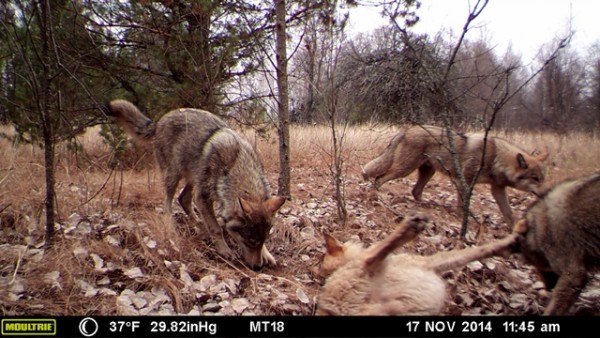By Ana Verayo, | April 23, 2016

A pack of wolves visits a scent station in the Chernobyl Exclusion Zone. The photograph was taken by one of the remote camera stations and was triggered by the wolves’ movement
It's been 30 years since the worst nuclear fallout in the world happened in Chernobyl, Ukraine and now, scientists reveal that the nuclear accident site is now teeming with wild animals.
Researchers from the University of Georgia's Savannah River Ecology Laboratory conducted a camera study to confirm prior findings that wildlife is thriving and flourishing in the Chernobyl Exclusion Zone (CEZ) after decades.
Like Us on Facebook
In April 1986, the Chernobyl Nuclear Power Plant exploded due to a faulty reactor design where explosive materials in fire and hot steam released five percent of the radioactive core into the Earth's atmosphere. The area was fully contained after the accident but health and environmental effects of this nuclear fallout are yet to be seen.
Previous studies were based on evidence of animal tracks around the CEZ, indicating wildlife presence however, in this new study the team utilized the first ever remote camera scent station survey to document the species living in the zone. According to lead author of the study, James Beasley from the SREL and Warnell School of Forestry and Natural Resources in Georgia, this camera study helped them determine that radiation levels do not have a significant effect on animal distribution.
Beasley confirms the findings of past studies that wildlife within the exclusion zone are now adapting and evolving from this long term exposure to dangerous radiation.
The camera system was established across the entire Belarus region of the CEZ and recorded photo evidence, direct observational evidence for everyone to see. In this new study, the team covered 94 sites, setting up 30 cameras that are swatched with a fatty acid scent to attract animals, on trees or structures for several days in every location.
To cover a wider range and to keep animals from visiting one station multiple times in a day, researchers placed the cameras two miles between each other, as observations lasted for five weeks. This method allowed researchers to document every species and their frequency of visits.
According to Sarah Webster of SREL and Warnell, the team's observations are targeting carnivores more since they are on top of the food chain, which also makes them prime targets for radioactive contamination. Webster adds that since carnivores are found on the higher levels of ecosystem food webs, they are more susceptible to bioaccumulation of contaminants.
The results revealed that the most highly contaminated regions are visited most by 14 species of mammals that include the gray wolf, red fox, and the Eurasian boar along with a canid species that can be commonly found in Europe and Eastern Asia.
The team also revealed that the animals often visit areas that cater to their basic daily needs like water and food. Beasley also adds that further studies are needed to fully analyze wildlife density and populations, along with survival rates.
This new study is published in the journal Frontiers in Ecology and the Environment.
-
Use of Coronavirus Pandemic Drones Raises Privacy Concerns: Drones Spread Fear, Local Officials Say

-
Coronavirus Hampers The Delivery Of Lockheed Martin F-35 Stealth Fighters For 2020

-
Instagram Speeds Up Plans to Add Account Memorialization Feature Due to COVID-19 Deaths

-
NASA: Perseverance Plans to Bring 'Mars Rock' to Earth in 2031

-
600 Dead And 3,000 In The Hospital as Iranians Believed Drinking High-Concentrations of Alcohol Can Cure The Coronavirus

-
600 Dead And 3,000 In The Hospital as Iranians Believed Drinking High-Concentrations of Alcohol Can Cure The Coronavirus

-
COVID-19: Doctors, Nurses Use Virtual Reality to Learn New Skills in Treating Coronavirus Patients







